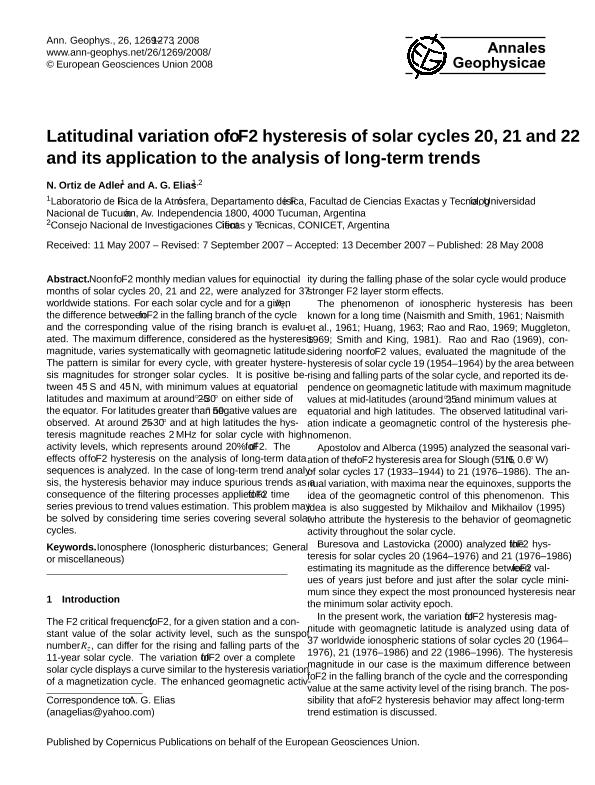Mostrar el registro sencillo del ítem
dc.contributor.author
Ortiz de Adler, Nieves del Carmen

dc.contributor.author
Elias, Ana Georgina

dc.date.available
2019-07-25T13:52:30Z
dc.date.issued
2008-12
dc.identifier.citation
Ortiz de Adler, Nieves del Carmen; Elias, Ana Georgina; Latitudinal variation of foF2 hysteresis of solar cycles 20, 21 and 22 and its application to the analysis of long-term trends; Copernicus Publications; Annales Geophysicae; 26; 5; 12-2008; 1269-1273
dc.identifier.issn
0992-7689
dc.identifier.uri
http://hdl.handle.net/11336/80259
dc.description.abstract
F2 monthly median values for equinoctial months of solar cycles 20, 21 and 22, were analyzed for 37 worldwide stations. For each solar cycle and for a given , the difference between F2 in the falling branch of the cycle and the corresponding value of the rising branch is evaluated. The maximum difference, considered as the hysteresis magnitude, varies systematically with geomagnetic latitude. The pattern is similar for every cycle, with greater hysteresis magnitudes for stronger solar cycles. It is positive between 45S and 45N, with minimum values at equatorial latitudes and maximum at around 25-30 on either side of the equator. For latitudes greater than 50 negative values are observed. At around 25?30 and at high latitudes the hysteresis magnitude reaches 2MHz for solar cycle with high activity levels, which represents around 20% of F2. The effects of F2 hysteresis on the analysis of long-term data sequences is analyzed. In the case of long-term trend analysis, the hysteresis behavior may induce spurious trends as a consequence of the filtering processes applied to F2 time series previous to trend values estimation. This problem may be solved by considering time series covering several solar cycles. F2 monthly median values for equinoctial months of solar cycles 20, 21 and 22, were analyzed for 37 worldwide stations. For each solar cycle and for a given Rz, the difference between F2 in the falling branch of the cycle and the corresponding value of the rising branch is evaluated. The maximum difference, considered as the hysteresis magnitude, varies systematically with geomagnetic latitude. The pattern is similar for every cycle, with greater hysteresis magnitudes for stronger solar cycles. It is positive between 45S and 45N, with minimum values at equatorial latitudes and maximum at around 25?30 on either side of the equator. For latitudes greater than 50 negative values are observed. At around 25?30 and at high latitudes the hysteresis magnitude reaches 2MHz for solar cycle with high activity levels, which represents around 20% of F2. The effects of F2 hysteresis on the analysis of long-term data sequences is analyzed. In the case of long-term trend analysis, the hysteresis behavior may induce spurious trends as a consequence of the filtering processes applied to F2 time series previous to trend values estimation. This problem may be solved by considering time series covering several solar cycles.
dc.format
application/pdf
dc.language.iso
eng
dc.publisher
Copernicus Publications

dc.rights
info:eu-repo/semantics/openAccess
dc.rights.uri
https://creativecommons.org/licenses/by-nc-sa/2.5/ar/
dc.subject
Ionosphere
dc.subject
Solar Activity Cycle
dc.subject
Fof2
dc.subject
Hysteresis
dc.subject.classification
Meteorología y Ciencias Atmosféricas

dc.subject.classification
Ciencias de la Tierra y relacionadas con el Medio Ambiente

dc.subject.classification
CIENCIAS NATURALES Y EXACTAS

dc.title
Latitudinal variation of foF2 hysteresis of solar cycles 20, 21 and 22 and its application to the analysis of long-term trends
dc.type
info:eu-repo/semantics/article
dc.type
info:ar-repo/semantics/artículo
dc.type
info:eu-repo/semantics/publishedVersion
dc.date.updated
2019-07-11T18:34:04Z
dc.identifier.eissn
1432-0576
dc.journal.volume
26
dc.journal.number
5
dc.journal.pagination
1269-1273
dc.journal.pais
Alemania

dc.journal.ciudad
Heidelberg
dc.description.fil
Fil: Ortiz de Adler, Nieves del Carmen. Universidad Nacional de Tucumán. Facultad de Ciencias Exactas y Tecnología; Argentina
dc.description.fil
Fil: Elias, Ana Georgina. Universidad Nacional de Tucumán. Facultad de Ciencias Exactas y Tecnología; Argentina. Consejo Nacional de Investigaciones Científicas y Técnicas. Centro Científico Tecnológico Conicet - Tucumán; Argentina
dc.journal.title
Annales Geophysicae

dc.relation.alternativeid
info:eu-repo/semantics/altIdentifier/url/http://www.ann-geophys.net/26/1269/2008/angeo-26-1269-2008.html
dc.relation.alternativeid
info:eu-repo/semantics/altIdentifier/doi/https://doi.org/10.5194/angeo-26-1269-2008
Archivos asociados
